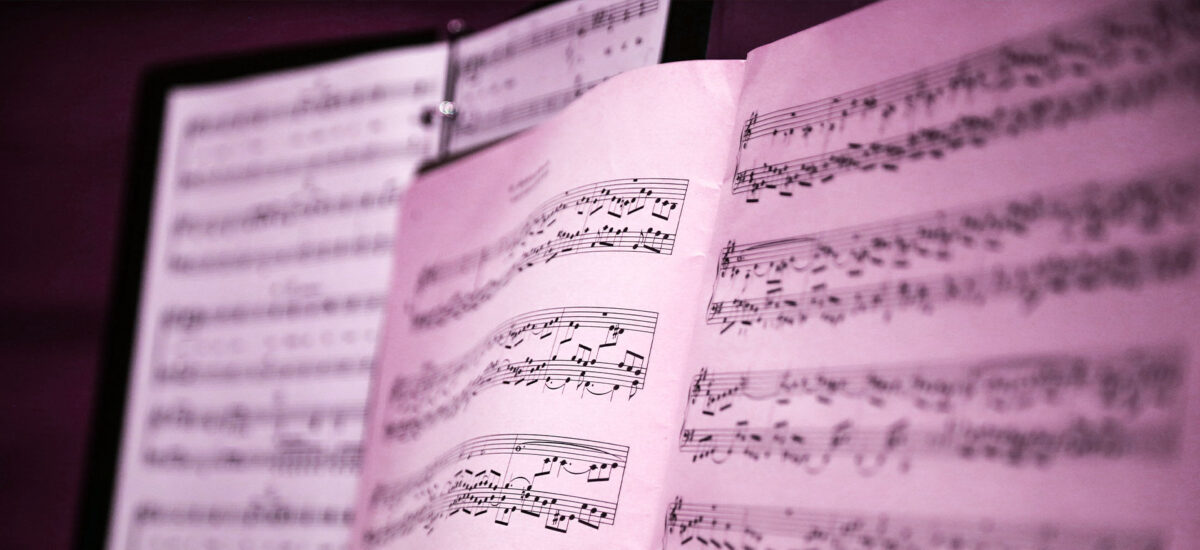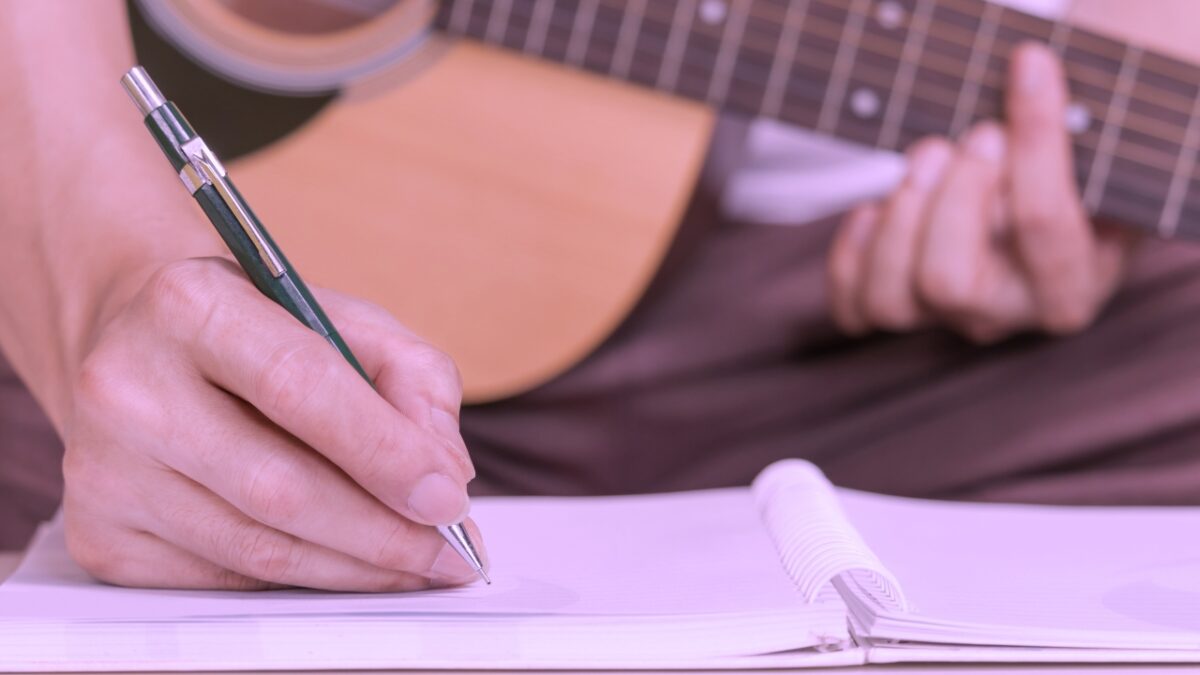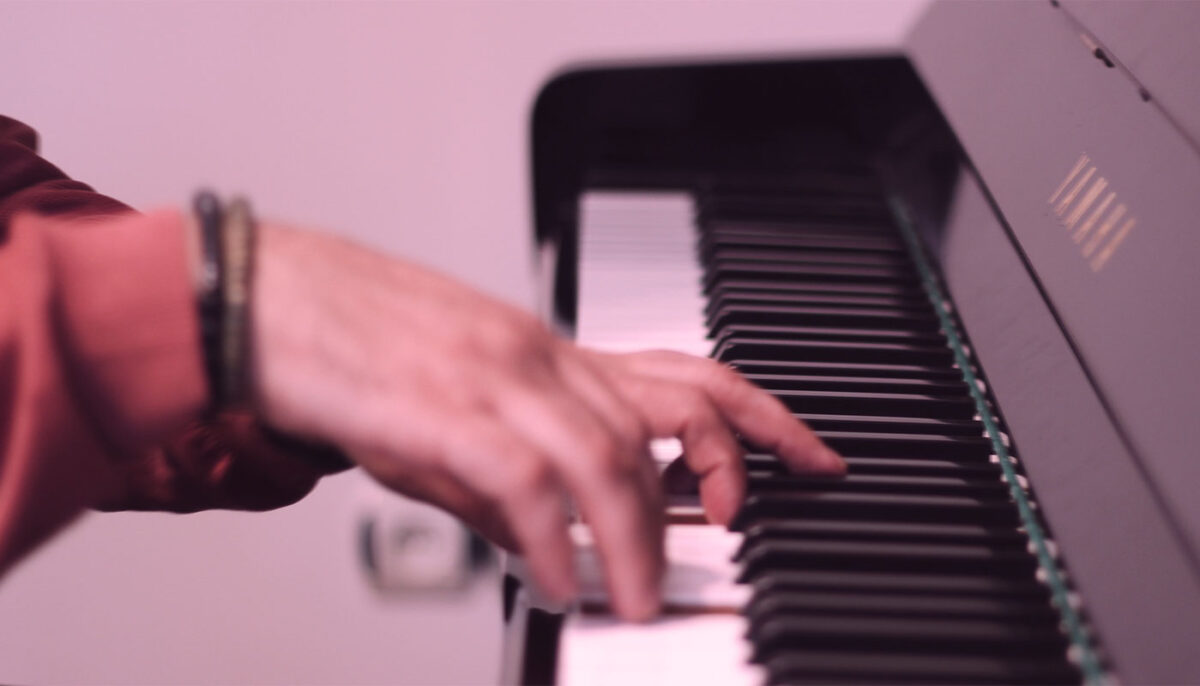
Songwriting is the art and craft of creating original songs by combining melodies, lyrics, and emotions to express thoughts, feelings, and experiences in a creative and meaningful way. It’s the meeting point of music and poetry. These two artistic disciplines fuse together in a song—part storytelling, part music composition.
Traditionally, a song comprises a lead vocal part with lyrics, often (but not necessarily) backed by an instrumental accompaniment. This intersection of music and lyrics is the essence of songwriting. When we think of a song today, we’re as much focused on the melodies, chords, and rhythms as any narrative in the words.
Writing songs is part of a grand, ancient oral tradition. A song can capture a memory or an energy specific to a certain moment in time, preserve it, and project it forwards for future listeners to appreciate.
This guide provides an entry-level introduction to songwriting and how to make a song from scratch. We’ll cover the basics of how to write a song, finding inspiration for music and lyrics, song structure and arrangement, as well as how to take advantage of hardware and software tools to improve your workflow. Whether you’re a beginner just starting to write your first lyrics or an experienced songwriter looking for fresh insights, this guide will inspire, educate, and empower you to create your own music.
Jump to these sections:
Introduction to songwriting
The world is a melting pot of diverse styles, genres, and traditions of songwriting—every culture has its own music. Throughout history, songs have served as vehicles for individuals and groups to express themselves and pass down wisdom through the generations.
Songwriting is about personal experience. So take it in your own direction, pursue what drives and interests you. Anyone can learn how to write music—and with the aid of modern digital technology, composing, songwriting, and producing have never been more accessible.
To begin with, let’s address some of the most-asked questions around how to start writing songs.
How do I start songwriting?
Songwriting begins with inspiration. A tricky concept to pin down and define, it broadly means the sense of exciting possibility of creating something new.
A song begins with a nugget of an idea, a feeling or a detail of life experience that catches your attention as poignant, poetic, or in some other way remarkable. Above all, the best way to improve your songwriting is immersion, which involves a large degree of trial and error. It so often happens that THE idea comes out of left field and catches you by surprise while you’re busy focusing on something else.
Different songwriters work in their own ways. Some write at the piano, some with a guitar in hand, others with a fresh sheet of paper, or more recently, a recording in a voice notes app while out on the move.
Computer sequencers and DAWs offer a full suite of digital composition tools, including realtime playback, a visual piano roll, and chord automation. In the modern music landscape, the craft of songwriting is overlapping more and more with electronic music production. To learn more, check out 12 essential production tips.

Why is songwriting so hard?
It can be tough writing songs for beginners for a few reasons. Writing a song that is unique and stands out can be difficult. With countless songs already written, finding fresh ideas, melodies, and lyrics that resonate with people can be a daunting task.
Songs often aim to convey emotions and tell stories. Expressing complex emotions and experiences in a concise and relatable manner requires skill and the ability to connect with listeners.
Crafting a song with a cohesive structure, including verses, choruses, bridges, and pre-choruses, requires an understanding of musical arrangement. And harmonizing the melody with suitable chords and chord progressions without a solid understanding of music theory can also be challenging.
For serious artists and songwriters, music is a lifelong commitment and an obsession. There is no shortcut to mastery, it’s something you need to be regularly, persistently working at to improve.
How much does songwriting pay?
The amount of money songwriters can earn varies greatly and depends on various factors. Music is a precarious and highly competitive industry. True, there’s big money and status to be won at the top, particularly with royalties and publishing deals.
Songwriters earn royalties when their songs are performed, recorded, streamed, or sold. Royalties can come from different sources, such as mechanical royalties (from the sale or streaming of recorded music), performance royalties (from live performances or radio play), synchronization royalties (from the use of music in TV, film, commercials), and more.
Songwriters can also make money through publishing deals. Songwriters may sign publishing deals with music publishers who handle the licensing and administration of their songs. These deals can involve advances (upfront payments) and royalty splits, where the publisher and the songwriter share the income generated by the songs. The terms of the publishing deal can greatly affect a songwriter’s earnings.
Most musicians exist in the middle ground, creating their work and sharing it with the audience around them, big or small. Many struggle to make a living from songwriting and performing alone, instead supporting their creative work with other sources of income. For more information on the industry side of things, head to our music publishing guide.

How to write a song
Learn how to write a song, from understanding basic song structure to creating chord progressions, writing melodies, and more.
1. Rhythm
Rhythm is the pattern of musical and lyrical accents, beats, and timing that gives a song its groove and sense of forward movement. It encompasses the way words and musical phrases are delivered and the overall pulse and feel of the song.
A catchy or memorable song owes as much to rhythm as the melodic hook or the lyrics.
A few aspects of rhythm in songwriting include:
Beat and meter: The beat is the underlying pulse or steady recurring pattern of accents in music. It provides the framework for rhythm. Meter refers to the organization of beats into regular groupings, typically measured in bars or measures. Common meters include 4/4 (four beats per measure), 3/4 (three beats per measure), and 6/8 (six beats per measure).
Groove and feel: The groove refers to the overall rhythmic feel or style of a song. It is influenced by elements such as the tempo, syncopation (accenting off-beats), the placement of accents, and the use of rhythmic devices like swings or shuffles.
Melodic rhythm: Melodic rhythm refers to the rhythmic patterns and durations of the melody itself. The way melodies are phrased and accented can greatly impact the overall rhythm of the song.
Lyrical rhythm: Lyrical rhythm refers to the rhythmic patterns created by the delivery of lyrics. It involves the placement of stressed and unstressed syllables, the use of repetition, rhyme schemes, and the alignment of lyrics with the musical beat. This is often critical to genres like rap music.
A song’s tempo and time signature are generally established early in the songwriting process, and we use these rhythmic aspects a lot to identify and categorize different genres and subgenres of music.
If you’re learning how to write music using a DAW, this is where songwriting crosses over with beat making and producing. Most DAW interfaces are laid out on a grid, so from the very outset we’re thinking about music in terms of the beat and rhythm.

2. Chord progressions
While a chord is a combination of notes played together to produce one sound, a chord progression is a sequence of chords, often repeating, which provides the main framework for the song. Chord progressions play a fundamental role in songwriting, providing the harmonic structure and foundation for melodies, lyrics, and overall musical expression.
The two most-used types of chords are major and minor. A major chord has a more resolute, optimistic tone, while minor chords are more serious and even mournful.
To hear this in action, listen to the piano part in “The Scientist” by Coldplay to get a sense of how major and minor chords sound in relation to one another. The song cleverly modulates between minor and major forms of the root chord, so the mood is sadder in the verses and more positive when we hit the chorus.
Chord progressions are inherently emotional and can help inform us of the emotions and mood of the song, from happy to sad, exciting to chilled-out, and everything in between.
For example, listen to the chord progression of i – III – VII – iv in “Without Me” by Halsey and you’ll immediately feel the wistfulness and longing that the chord progression evokes.
To get started writing chord progressions, here are a few common chord progression examples to start:
- I-IV-V (1-4-5): This progression is widely used in many genres, including rock, blues, and pop. It consists of the tonic (I), subdominant (IV), and dominant (V) chords.
- I-V-vi-IV (1-5-6-4): This progression is often referred to as the “four-chord progression” and has been a staple in pop music.
- I-VI-IV-V (1-6-4-5): This progression is frequently used in rock, folk, and country music. It has a straightforward and catchy sound.
For even more chord progression ideas, check out our guides on pop chord progressions and R&B chord progressions.
3. Melody
Melody in songwriting refers to a sequence of single notes played or sung in a deliberate and organized manner. It is the aspect of music that is most easily recognized and remembered by listeners.
Good melodies use repetition to establish memorable phrases and hooks that stick in the listener’s mind. And the topline melody generally takes center stage in a song, containing its main message and identity.
Of course, there are many different approaches to writing and using melodies in songwriting. At the root of a great melody, you will find a delicate balance of tension vs. release, complexity vs. simplicity, or a surprising direction change vs. what the listener expects to follow.
When writing your melodies, here are some other aspects to consider:
- Pitch and intervals: Melody is primarily concerned with the pitch, or the highness or lowness of a note. Melodies are created by arranging different pitches in a specific order. The intervals, or the distances between the pitches, contribute to the contour and movement of the melody.
- Rhythm and timing: Melodies are not only about pitch but also about timing. The rhythm and duration of each note within the melody contribute to its overall character. The placement of long and short notes, rests, and rhythmic patterns add rhythmic interest and dynamics to the melody.
- Harmony and accompaniment: Chords or harmonies provide harmonic context to the melody. The interaction between the melody and the accompanying chords influences the overall sound and emotional impact of the music.
- Repetition and variation: Repetition is a common technique used in melodies to create familiarity. Repeating melodic phrases or motifs can make a melody more memorable. Variation involves altering the melody slightly while retaining some recognizable elements, adding interest and development.
A great example of a repetitive, catchy, and powerful melody is Taylor Swift’s “Shake It Off.”
4. Lyrics
Lyrics are the words or text that are sung or spoken in a song. They convey the message, story, emotions, and themes of a song.
Songwriters work with song lyrics in different ways. Common themes are love and human emotions, often depicted through descriptions of scenes and characters, using narrative to paint pictures with words. Lyrics are usually rhyming lines of poetry—rhyme can work together with melody to give each line an interesting shape and turn it into a catchy, memorable hook.
Some artists are equally famous for the lyrics in their songs as the music, for example Bob Dylan.
For others, lyrical meaning is less significant than how the words sound—using the human voice like an instrument.
In some cases, you may pen the lyrics first then later set them to music. On the other hand, it’s just as common for songwriters to use nonsense placeholder lyrics, or abstract hums and ahhs, before refining the words at a later stage.
Here are some quick tips for lyric writing to get you started:
- Write lyrics based on personal experiences, emotions, and observations
- Create a catchy and memorable line build your lyrics around
- Use imagery and metaphors to expand on your central idea
- Use contrasting repetition and variation in your lyrics to give your song movement and interest
- Keep your lyrics simple to convey your message in a way that is easy to understand
- Get feedback on your lyrics from friends or fellow songwriters
5. Song structure
Song structure refers to the organization and arrangement of different sections within a song. It provides a framework for how the various parts of a song fit together, creating a cohesive musical composition. A song’s structure is its overall shape, the journey it takes the listener on from start to finish.
Much like any story has a beginning, middle, and ending, song arrangements tend to be divided into familiar sections, each serving specific functions.
Some common song structures include:
- Verse-chorus (ABABCB): The verse-chorus structure alternates from verses and choruses, with occasional bridges (C sections).
- Verse-pre-chorus-chorus (ABABCBB): This expands the verse-chorus structure by adding a pre-chorus section between the verse and chorus.
- AABA: This consists of two verses (A sections) followed by a contrasting bridge (B section), and then a return to the initial verse (A section).
- ABAB: This structure features two contrasting sections, typically referred to as “A” and “B.”
Most songs (in modern western music, at least) follow a verse-chorus structure. A narrative in the lyrics evolves over multiple verses, intercut with a repeating chorus or refrain that is typically the peak energy of the song.
The intro often states the song’s main hook—an obvious example of this is “Seven Nation Army” by the White Stripes. Other times, the intro and outro are completely separate sections with unique musical material.
The bridge introduces a musical variation to a song’s main themes, usually occurring late in the track before the climactic final chorus. Listen out for the bridge here in Rihanna’s “What’s My Name?” (starting at 2:54).
6. Arrangement
Arrangement in songwriting can refer to the organization and structure of the different sections, instruments, and elements within a song. In many music genres, the traditional song arrangement features a lead melody accompanied by a rhythm section. But of course, you are completely free to choose the instrumentation for your song, from a simple solo part to an elaborate orchestra.
Using a DAW and sampled sounds, it’s possible to build up an arrangement with a practically unlimited number of tracks. The sky’s the limit, but remember that simplicity often has more effectiveness and cut-through than something overly complicated. Our guide on electronic music production can help you dial in your sound if you’re looking for something more modern.
When choosing instruments to support your song, remember to consider the song’s genre and what instruments are typically used. For instance, you wouldn’t typically hear a flute in a country song unless it’s a deliberate choice to add that sort of timbre to the song.
Native Instruments has hundreds of high quality sounds and instruments to choose from. A great way to get started experimenting with your musical arrangement is by downloading KOMPLETE START, a free bundle of professional-grade instruments and synths to elevate your songs.
7. Recording, mixing, and mastering
After your song is written and arranged, it’s time to record your music for a demo or a professional recording.
How you choose to record a song will depend on whether you’re using live or electronic sounds. To record live instruments or vocals, you’ll need a microphone. These days, most people use a DAW as a recording device, giving you as many tracks as you need for different takes or overdubs. And using tools like MIDI controllers, keyboards, and recording equipment that connects to your computer can speed up the recording process and help refine your sound.
The traditional role of the songwriter that only writes songs without additional production work still exists, but with easy access to studio-grade equipment, it’s increasingly common to produce your own music. Learning production is within reach for most people, giving you total control and independence to build your platform as an artist.
On the production and processing side, iZotope Elements Suite provides everything you need to mix and master tracks to a professional standard.
Start writing songs
We hope this guide has given you a solid understanding of how to write catchy, memorable songs in an easy-to-understand way. Remember to find inspiration from various sources, keep your lyrics simple yet meaningful, utilize imagery and metaphors, and engage in the art of storytelling.
With dedication, practice, and an open mind, you can create songs that resonate with both yourself and your listeners.
For even more songwriting tips, check out our interview with professional songwriters in the industry. And get started writing your own songs using tools from Native Instruments, including the free KOMPLETE START bundle that gives you 16 pro-grade synths and sampled instruments, plus effects, loops, and samples.















